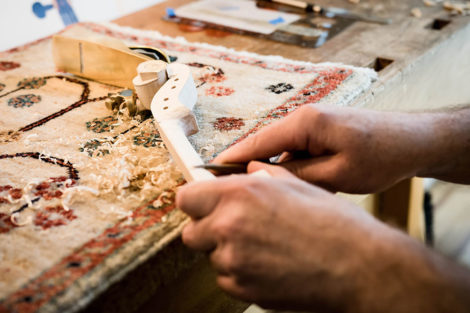Building innovation capacity in the public sector is essential to deal with the complex problems governments face. But how do we go beyond one-off trainings and really bring about new ways of working?
We think about innovation in government as a craft, made up of the principles, methods, functions and conditions that enable it to happen. And this means we should think of government innovators as craftsmen and women. Looked at this way, craftsmanship helps us develop the skills of public servants in a more rounded way, shifting what it means for learning about innovation.
Traditionally, the notion of craftsmanship doesn’t refer to public servants or policy makers.
Instead, we think of handmade work - things you can hold, use and experience - and the expertise and the years of practicing that it takes to be a master carpenter, violin maker, boat builder or chef. Henry Mintzberg described strategy making as an act of craftsmanship, and the same goes for policy making. Although not ‘physical’ in the same way, they also rely on a similar honed mastery we’d expect from an Antonio Stradivari violin.
Thinking about it in these terms provides us with a broader frame than looking at just skills or methods on their own, because craftsmanship goes beyond these. Traditional training approaches have typically focused on the methods and tools that are ‘teachable’ or those with more measurable learning outcomes like design thinking or data analytics. But these are just parts of the whole.
"In order to improve the public service in general, one-off workshops and training sessions won’t cut it."
Given the speed of change and levels of complexity that governments are currently facing, we need a workforce that is learning, developing and honing their skills all the time. This is what craftsmanship is.
By framing learning around a craft, it changes how we look at capacity building and starts to create a much more holistic system of experiences, touchpoints, actors and support mechanisms that will make it happen.
The act of ‘making’
Whether it’s a violin or a policy, the act of “making” is key to craftsmanship. It refers to the way things are made or done, and as Richard Sennett points out in his book The Craftsmen, craftsmanship is about “the skill of making things well” and taking pride in doing a job well.
But craftsmanship is more than skills. It also involves the commitment to make things well, and the judgement to assess whether things are made well. These are rooted in a set of values and norms specific to a certain field or domain, and are driven by personal and collective aspirations to achieve mastery and advance a field.
The elements of craftsmanship
When we zoom out and look at craftsmanship as holistic system, we see more elements, which form together the ethos of a craft and the identity of a craftsman.
Outputs or products
At the heart of a craft is the product or output that is created. A violin, a chair or table, a policy paper on primary education, an app to promote healthier living, or a business strategy to sustain the future relevance of an organisation. All these can be outputs created by a craftsman.
Outcomes
Outputs are not the end in themselves; they are the means to achieve a certain outcome. A violin allows a musician to play a piece of music, bringing joy and delight to an audience in a theatre. Chairs and a table allow a family to have dinner together and build meaningful relationships. And a policy paper may stipulate a course of interventions that result in better educational outcomes for an entire country.
Materials or information
To create the products and bring about the desired outcomes, a craftsman works with specific materials that are transformed or shaped into something useful or valuable. These working materials may include a specific substance (e.g. wood), medium (e.g. digital), data, information or content (e.g. on specific domain knowledge or policy area).
Tools
These shape or modify the working materials. Tools may include a hammer to construct a chair, a programming language to create an app, post-it notes to shape ideas, Lego Serious Play to develop a strategy, worksheets or toolkits to support collaboration and set up partnerships, or visualisations to analyse data.
Tools are often linked to a specific craft, and craftsmen can adjust or adapt their tools to their own personal needs and preferences, they can think outside the toolbox.
Workspaces/platforms
A workspace helps a craftsman work in a safe, comfortable and efficient environment. A violin builder needs their space set up so they can work effectively. For groups of experts to work on a product, they may use (online) platforms (e.g. Github) to share documents, knowledge and work together on components of a bigger system - like we see in the open source community. And when a team of specialists work on strategy or a policy, they may need a collaborative space, with whiteboards to support their conversations.
Skills
Tools and materials on their own aren’t worth much without the skills to turn them into something useful. A craftsman’s skills are their specific methods or techniques. For example, the skills to shape a piece of wood with a chisel, build a quick prototypes with what you have to hand, or carry out ethnography to better understand user perspectives.
Judgement
All the elements mentioned above come with judgement. This gives the craftsman the ability to assess the quality of their work and the materials they use, or make decisions on the best tool to get the job done. This judgement is informed by norms and standards of what is considered a job well done - or even a job worth doing - which may be implicitly or explicitly shared with a wider group of practitioners.
Commitment
Skills and judgement come with commitment; a craftsman’s internal drive or motivation to do a job well. This commitment may be rooted in a certain set of values, an ethos or a code of honour that is shared within a certain domain.
Community of practitioners
A single tree does not make a forest, and nor does a craftsman on their own make a craft. It is embedded in a community of practitioners, which can build on decades of experience and tradition. These can be well structured and organised – like with traditional guilds – or more loosely formed – like we see with the various networks of public innovators.
Body of knowledge
As well as generally sharing norms, standards and values, such communities normally also have a body of knowledge which often comes with its own jargon. While jargon around technical terms can increase the efficiency of communication among its members, it may also alienate outsiders. This is particularly the case when confusing jargon is used instead of plain English.
Learning mechanisms
What makes communities of craftsmen thrive is their capacity to share that craft and spread their knowledge. They may have either simple or sometimes very sophisticated learning mechanisms in place that allow the transfer of skills, knowledge, norms, values, etc. across existing members and newcomers.
For example, traditional guilds were based on apprenticeships. This allowed not only for the transfer of explicit skills and knowledge, but also the transfer of tacit knowledge and certain norms and values.
Why we need to ‘learn by doing’
If we describe craft as “the skill of making things well”, then the crux of the matter is in the word “making”. It's about doing or creating.
This is not about training on analytical skills – as we see many traditional government schools teaching – but about action, doing, and “making change”. The best way to do this is to allow public servants to experience decision making in the full complexity of reality - rather than in a classroom detached from their real work.
Ideas need to be successfully implemented to generate actual value. “Doing” is at the heart of the innovation process and should therefore form the premise of any innovation learning programmes.
By doing, we experience the consequences of our decisions, and by reflecting on these experiences we then identify effective and ineffective patterns that shape our future actions and practices.
"This means we need a focus on learning in practice – as opposed to just learning about practice."




